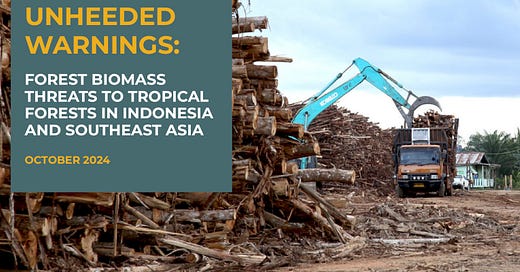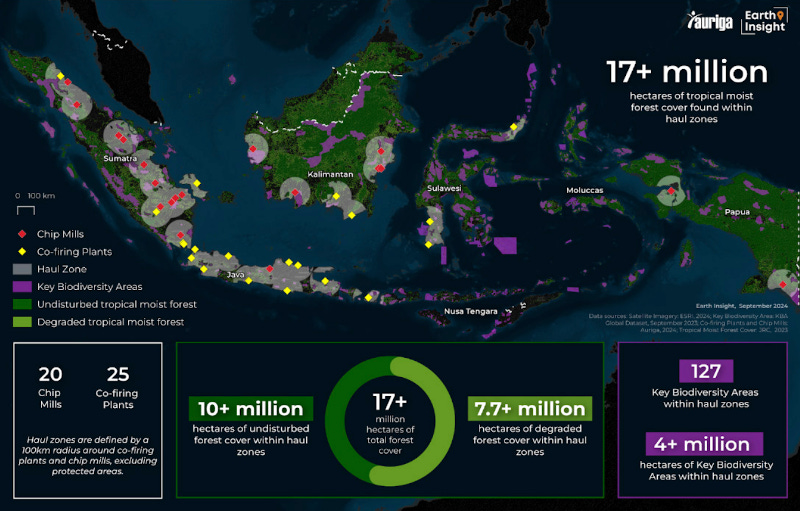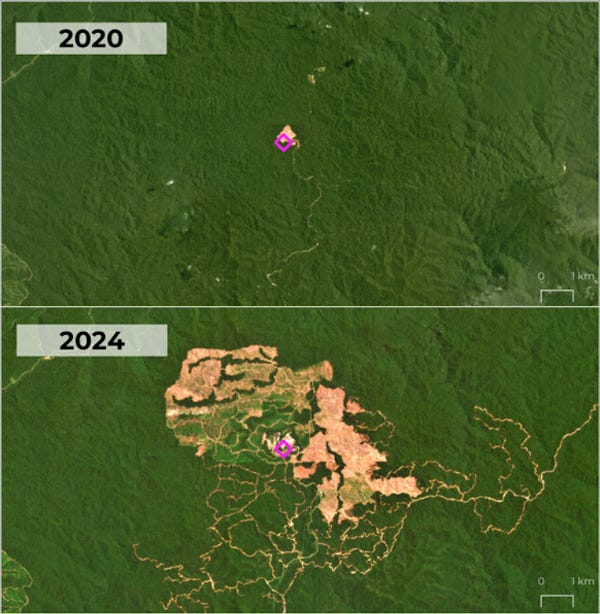Woody biomass is a false climate solution and a massive threat to Indonesia’s forests
A new report highlights the threat to Indonesia’s forests from industrial biomass demand.
In February 2021, more than 500 scientists signed a letter to world leaders urging them “not to undermine both climate goals and the world’s biodiversity by shifting from burning fossil fuels to burning trees to generate energy”.
The letter notes that increased use of bioenergy in Europe has already led to large increases in logging and that promoting bioenergy creates a model that “encourages tropical countries to cut more of their forests”.
A new report, by Earth Insight, Auriga Nusantara, Forest Watch Indonesia, Trend Asia, Solutions for our Climate, and Mighty Earth, warns that three years later, the scientists’ prediction is taking place across Southeast Asia.
The report, “Unheeded Warnings: Forest Biomass Threats to Tropical Forests in Indonesia and Southeast Asia”, was launched during the Summit of the Association of Southeast Asian Nations in Vientiane, Lao PDR.
Indonesia plans to co-fire its 114 coal power plants with woody biomass under its energy transition plans. This will require huge areas of fast-growing industrial tree plantations. Trend Asia warns that co-firing with wood pellets could result in up to 2 million hectares of deforestation per year.
To make matters worse, subsidy programmes in South Korea and Japan are driving increasing demand for wood pellets and wood chips from forests across Southeast Asia.
From 2021 to 2023, South Korea and Japan bought more than 99% of Indonesia’s wood pellet exports. And Indonesia’s wood pellet exports increased hugely in those two years. In 2021, Indonesia exported 49.8 tonnes of wood pellets to South Korea. By 2023, this had risen to 68,025 tonnes. Exports to Japan increased from 54 tonnes to 52, 735 tonnes.
From 2012 to 2021, Indonesia’s production of wood pellets grew from 20,000 tonnes to 330,000 tonnes.
10 million hectares of forest under threat
The report includes an analysis of forest within “haul zones” around co-firing plants and wood chip mills. Haul zones are defined by a 100 kilometre radius around plants and mills, excluding protected areas.
The report states that,
Indonesia’s 10% co-firing mandate poses a threat to 10 million hectares of undisturbed cover in wood chip and pellet haul zones. It is estimated that using wood for a 10% reduction in coal at Indonesia’s largest power plants could trigger the deforestation of an area roughly 35 times the size of Jakarta — resulting in CO₂ emissions almost five hundred times higher than current levels.
The expansion of industrial tree plantations to meet demand for woody biomass also threatens to increase deforestation. Within Indonesia’s so-called energy plantation forests [sic] is a total area of more than 400,000 hectares of undisturbed forest. Energy plantation forests (Hutan Tanaman) cover an area of 1.2 million hectares across the country.
PT Biomasa Abadi
Forests in Gorontalo province on the island of Sulawesi are being clearcut for export to Japan and South Korea. In 2023, a wood pellet processor called PT Biomasa Abadi exported 126,441 tonnes of timber from Gorontalo. “There is clear evidence of whole logs being processed into wood pellets for export, which indicates clearance of biodiverse forests,” the report states.
In a press statement about the report, Agung Ady Setiywan of Forest Watch Indonesia says,
“Our field investigations show Gorontalo is Ground Zero for an export wood pellet industry that is clearing intact forests and harvesting full logs. It is expected to grow exponentially as industry players go into new concessions, such as in North Kalimantan.”
Woody biomass is a false solution
Burning wood pellets emits CO₂ to the atmosphere. Emissions from burning wood are similar to those from burning coal per megawatt hour. Biomass power plants can even end up emitting as much as 60% more CO₂ than modern coal plants per megawatt hour.
The argument, pushed by governments and industry, that the emissions can be ignored because new trees will absorb them in the future is both wrong and dangerous.
The obvious problem is that trees take decades to grow and absorb the CO₂ emitted. And if forests are cleared to make way for biomass plantations the carbon stored in the forest is also emitted to the atmosphere.
A press statement about the report points out that,
“Carbon debt payback time” is how long it takes regrowth to remove carbon emissions after wood is burned for energy. If wood displaces coal, the carbon debt payback time is estimated between 40 and 115 years. Payback estimates for tropical forests range from 30-120 years for non-peat soils, and more than 900 years for forests growing on peatlands in Southeast Asia.
Timer Manurung, Executive Director of Auriga Nusantara, says,
“Burning biomass is clearly a false energy solution. Deforestation for new plantations and exports poses a double jeopardy for Indonesia. Japan and South Korea are driving the market for biomass plantation expansion. At the same time, the government’s co-firing policy could increase woody biomass consumption up to 8,400%, which poses a huge threat to remaining forests and local communities. Our climate and critical forests must be safeguarded from false climate solutions. There is an urgent need to stop the rush to burn forests for energy and invest in protecting and restoring nature for our shared future.”








Thank you very much for making this important point
This “woody biomass” scheme is the same issue as biofuels, corn-ethanol, diesel from palm oil, etc. People, try to understand this simple little fact: A tonne of CO2 is a tonne of CO2, regardless of its source. If you burn it, the flame rejects your claim of source, and turns in into plain, old CO2. And with the lag-time of regrowth, it ends up in the oceans before it ever gets near a growing tree. Not to mention the CO2 and methane loss from disturbing the forest floor and all other living things in the biome. Did you know, “they” are developing a sorghum that makes better use of soil nitrogen so that it needs less fertilizers to make fibre for fuel-alcohol production? This is yet more biofuel garbage thinking. But cars and trucks pay more for their food than humans do, so fine, let’s all grow food for the machines to eat, and tear down the remainder of this planet to do that, and let the “deplorables” starve. Business people never cared about biodiversity anyway, all life forms either have economic value or they are in the way. Either way, they get cut down.